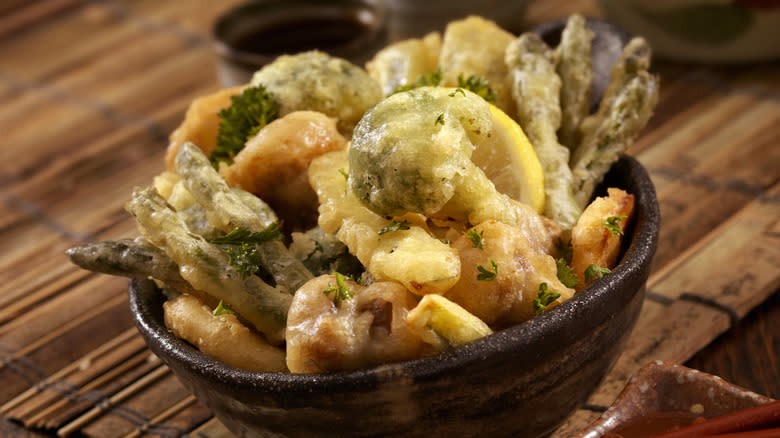The Flour Tip For Fried Foods With Unbeatable Crunch

Flavor is just one aspect of our enjoyment of food. Texture plays a similarly important part, especially when it comes to fried foods. No matter how tasty it is, even a freshly fried dish isn't satisfying when it doesn't yield that palpable, audible crunch as we sink our teeth into it. Dredging food with flour goes a long way in creating that delightful crackle, but for an unbeatable crunch (and a golden crust to match), our tip is to use tapioca flour.
You might be more familiar with tapioca being used for soft or gummy food items like pudding and boba pearls. However, this starch, which is derived from the cassava root pulp, has plenty of practical uses. When used to make a slurry, it's a neutral-flavored thickening agent and, unlike cornstarch, helps soups, sauces, and pie fillings retain their creaminess even when they're frozen. Tapioca flour can replace wheat flour, too, for gluten-free baking. The Brazilian cheese bread pão de queijo is traditionally baked with it, and it's known for being soft and chewy inside yet golden brown and crunchy on the outside.
The capacity of this starch to create a delectable crust isn't limited to baking. Give your fried foods a similarly satisfying crunch by coating them in tapioca flour before they hit the frying pan. Since tapioca flour is very absorbent, it also soaks up the moisture from the surfaces of your food items, which is one way of minimizing the risk of hot oil splatters.
Read more: 15 Different Ways To Cook Fish
Give Fried Foods A Thin, Crispy, And Gluten-Free Crust With Tapioca Flour

Although other coating agents like baking soda can also make fried foods crunchy, tapioca flour's advantage is that it creates a thin crust, which lets you immediately savor the flavor of the dish after feeling and hearing that delectable crackle. It's great for making tempura batter, with the coating lightly puffing up as it fries in hot oil. It doesn't get chewy, however, so the delicate flavors of veggies like carrots, eggplants, and zucchini still burst through. Tapioca flour also draws in excess moisture and can help keep food from becoming soggy — always an off-putting texture when it comes to fried dishes.
Another cooking tip is combining it with rice flour for an extra-light batter. Apply a 1-to-1 ratio for both types of flour and then add club soda instead of using water. This coating can keep fried food crunchy for as long as an hour after you've removed it from the oil. Turn the batter into another vehicle for flavor, too, by adding spices and seasonings.
An extra benefit of using this starch is that since it's gluten-free, it's safe to use for cooking when you or the people you'll be feeding are either sensitive to or intolerant of gluten. Check that the packaging of the tapioca flour you purchase is labeled as gluten-free to be certain.
Read the original article on Tasting Table.


